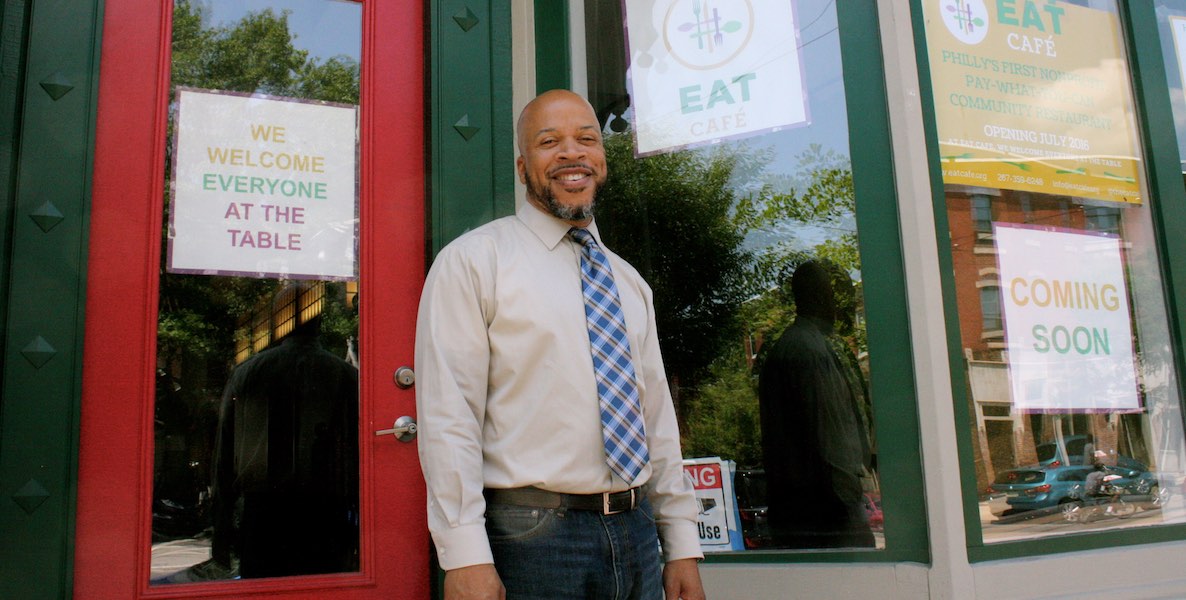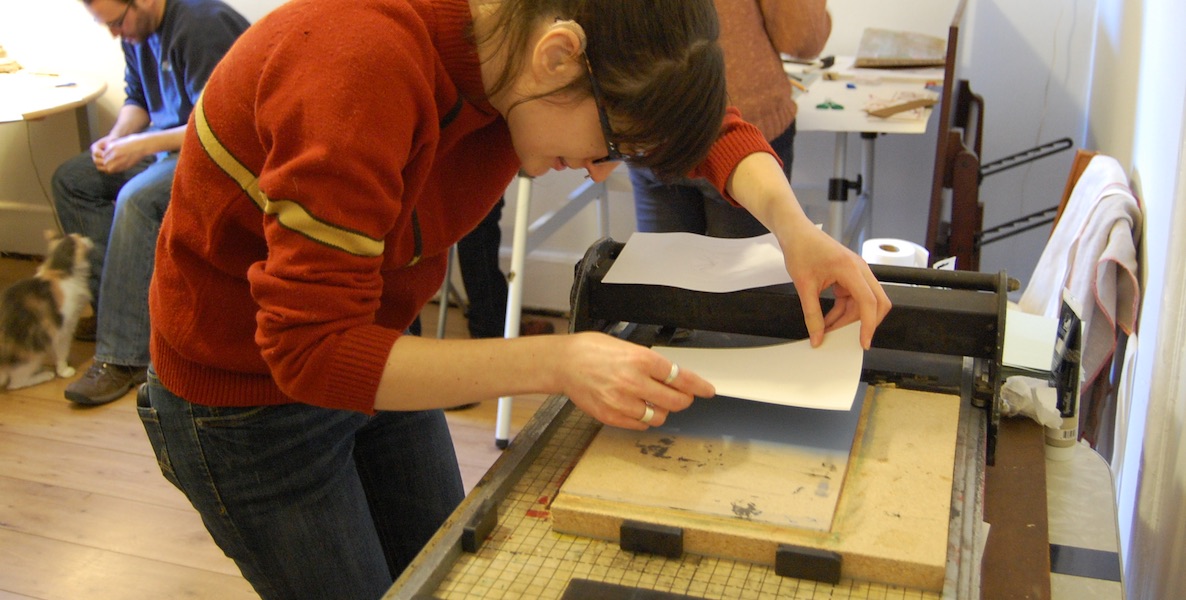Mary Tasillo, co-founder of Philly’s largest library of zines admits she’s a bit of a throwback. After all, she’s dedicated all her spare time to producing, collecting and encouraging a literary art form that was niche even before the Internet—an art form that many young people may never even know about in this day of the blog.
But to hear Tasillo talk about is to see the zine not as a piece of history to be preserved, but as a form of communication that is active and alive and vibrant. Her West Philly library and print shop, Soapbox, has 2,500 zines from around the city and country. And the collection is growing as the days go by, either by amassing zines at industry festivals and shows or by nabbing a copy of zines produced in their growing workshop, where several folks a month stop in to use their letter-blocks and screen printers and peruse their library
In fact, the project has grown so much in the last eight years that Tasillo is in the process of moving Soapbox, scaling up uh, out of its mom’s house: Soapbox is moving into the basement of a nearby church on Kingsessing Avenue later this year. Up until earlier this year, Soapbox operated out of the first floor of Tasillo’s own home, a labor of love that was also kind of a grind.
But it all was very much worth it to help defend her beloved artistic medium.
“I knew about zines in high school in the 90’s, but I wasn’t making them then,” says Tasillo. “As I got a little order, I got into art-making and writing, and I began to see making books as a way to combine those things.”
Tasillo dabbled in printing while in high school in rural west-Pennsylvania, before shipping off to Oberlin College and later Bennington University—she has a type, she admits—and arriving in Philadelphia in 2004 to finish a master’s degree in art at the University of Arts and learn the art of bookmaking proper. Tasillo says she’d wanted to open her own print shop, and that Philadelphia, at the time, was dying for a more accessible place for average citizens to print their own materials.
For some, it’s therapy. For some, the physical element of assembling your own tiny book or magazine—the tactility of it—is far more freeing and consuming than simply hammering out your feelings on a blog or retweeting a sarcastic .gif that most accurately represents your feelings toward the presidential administration.
Back in the mid-aughts, zines were in a precarious place: By then, blogs were becoming prevalent enough to push zines toward obsolescence, but not enough that zines were turning into objets des art or cultural markers. Tasillo knew that the zine scene—and small-batch printing itself—needed a lifeline, and organizing within Philly. Creating zines and books had not just become her hobby, but her passion. She saw zines as a way for people not only to control their own narrative, but as a way to deliver that narrative by their own means of self-created literature, a fully-personalized and self-actualized means of self expression untouched by any other art form—and she didn’t want to see the internet destroy that.
The Philly scene, she thought, was too scattered to protect itself. “There were a bunch of people running around back then who could do letter-press printing, but there was nowhere in the city, outside of the universities, where you could actually use the equipment,” says Tasillo. “That became a big impetus for me asking, ‘How can we get together and have a shared shop?’”
But the concept was just too daunting to tackle on her own. She’d have to acquire not only the place, but the equipment, and find a way to work running a creative space into her life. She benched the idea before meeting Charlene Kwon, another zine enthusiast, in 2009; Tasillo says that the two were applying for the same printing grant at the time. Together, they developed a plan to open their own creative space, and to do so on a budget. They both thought that there had to be a community space in Philadelphia where average citizens could go and create their own books and publications. So how did a couple of otherwise-cash strapped art kids end up founding a genuinely popular and well-attended print shop?
They bought a house together, and put Soapbox on the first floor. For a while, Tasillo and Kwon shared the second floor of the house, deep in West Philadelphia, and split the bills. Kwon has since moved out, but Tasillo still lives there, although she won’t have to deal with visitors printing in her actual home for terribly much longer. “It can be a little hard, people can show up whenever, even outside of the scheduled time,” she says.
By now, I’m sure you’re at least a little surprised that so many people are actually still making ‘zines, which is absolutely fair: No prior communication medium, it seems, could be more easily obliterated by the proliferation of the internet and blogging. That’s even in the age of old being new again; vinyl records have returned from the dead as the official music medium of cool guys who value sound quality, Star Wars is suddenly cool again and Shinola has made a huge comeback—and it still doesn’t seem like zines should continue to be part of a zeitgeist.
After all, why go through the mind-numbing process of manually blocking your own text in a magazine written by you alone that will only circulate to you and the rest of your friends, if they get around to picking it up? Why go through the trouble, the crucible of alignment and writing that results, after hours and hours of work, in a 16-page booklet?
Tasillo saw zines as a way for people not only to control their own narrative, but as a way to deliver that narrative by their own means of self-created literature, a fully-personalized and self-actualized means of self expression untouched by any other art form—and she didn’t want to see the internet destroy that.
Because like any artform that stands to be forgotten, it has immense latent power that can be tapped by those who are willing to put in the time to learn it. For some, it’s therapy. For some, the physical element of assembling your own tiny book or magazine—the tactility of it—is far more freeing and consuming than simply hammering out your feelings on a blog or retweeting a sarcastic .gif that most accurately represents your feelings toward the presidential administration. For others, it’s a useful way to both messages and art on their very own terms, without being subject to Tumblr hysteria or Tweet heat: A zine can be a concentrated, personal message that touches on only the things you care about the most, unmolested by Disqus comments or Facebook likes. A zine doesn’t need advertisements or columnists or even readers; all it needs is a purpose and a maniacally devoted editor, and it’s good to go. As such, zine culture still exists— if not exactly thriving—in some interesting little niches.
Zines are actually thriving among the queer and trans communities, for instance, because of their willingness to touch on subjects that range from trans-anatomy to queer intersectional subjects. And there’s a sizeable zine scene that focuses on the original intent of zines: proselytizing about burgeoning music scenes and bands that have yet to be discovered but for the devotion of uber fans and scenesters willing to make their own magazine about them. Sure, zines have taken on something of a boutique darlingness, but they’re still around, and their aggro milieu completely in tact.
In other words, zines are the real dope, baby, and Soapbox is trying to keep it that way in offering people the means and facilities to create their own, while preserving the venerable history of the medium in their aforementioned physical library (although, Talisso says, zines are pretty slim, and that you’d expect a library of 2,500 anything “to look a little bigger”).
“There’s something special about the hands-on aspect of it.” says Tasillo. “We all spend so much time on the computer. It’s important that we have something that’s different.”
Soapbox is a non-profit, and as such, Kwon and Tasillo are both volunteers. The only paid people who put in time for Soapbox are the people who run their regular workshops. Tasillo’s got a day job working for an architectural firm in Center City, and admits that keeping the doors open at Soapbox can be strenuous, even with the help of grants from the Philadelphia Cultural Fund, the Corzo Center for the Creative Economy, and Pennsylvania Council for the Arts, and fees from members and folks who stop by to use the studio.
As the group expands to its new digs on Kingsessing Avenue, it hopes to attract some new members and participants, and perhaps expand the capabilities of the studio itself to include private studios for creators and full-time employees to staff the studio so that creators won’t have to schedule visits to use the facilities.
That’s a bit down the line though. First, Soapbox has to reckon with their big move and find a way to continue to scale and offer those who use their facilities the kind of intimate, hands-on experience they’ve grown used to. But Tasillo is patient; she did, after all, wait several years to begin her own print shop, and more than half a decade after that to move that print shop out of her own actual home. To her, defending the zine and self publishing scene is a vocation, not something that can be abandoned after it receives its proverbial shot in the arm.
Header photo courtesy of Soapbox






